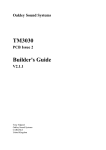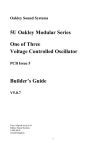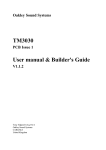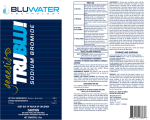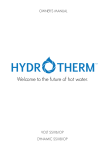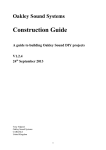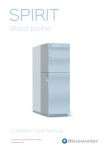Download How Salt Brominator`s Work - Canadian Hot Tub Retailer
Transcript
How Salt Brominator’s Work
The Bromine Device
is an in-line halogen
generator, used to
produce bromine from
a precursor of NaBr.
Salt
Free Bromine
The Genesis Salt System from Pioneer will be used as an example.
Brominator (Components)
There are 3 components:
1.
2.
3.
Digital Control Box
Bromine Generating Electrode Cell
PVC Cell Chamber
Controller
Brominator (How It Works)
-
After salt (sodium bromide) is added to the water, you simply set the
control box to the desired bromine production level.
As the spa water circulates, a small amount of the bromide
salt contacts the electrode cell and is broken down into bromine.
Later, as part of a perpetual cycle of bromine production,
the bromine will revert to salt again for circulation through
the electrode cell...creating an endless supply of the bromine your
tub needs for sanitizing.
Salt
Free Bromine
Brominator (How It Works)
Sodium bromide ("NaBr" - a close relative to
sodium chlorine - "NaCl" - otherwise known as
table salt) is added to your spa's water. The
dissolved bromide ions are circulated through a
bromine generating contact cell located in your
spa plumbing. This converts the bromide ions
into free bromine (bromine is the recommended
sanitizer for hot tubs and spas)
The free bromine attacks nitrogen based compounds and breaks them
down, then reverts back to sodium bromide (salt) --- thus creating a
perpetual cycle. Additional sodium bromide is only added when your
water level declines due to splash out, or when you drain and refill the
tub.
Brominator (How It Works)
The system's electrodes are comprised of high
density, ultra-porous "graphite". The controller
operates at extremely low DC voltages, resulting
in the electrical cost of operation at just pennies a
day.
The Brominator electrode is made up of 2 of
these unique and powerful plates. The plates
measure 1 inch wide by 8 inches long and 1/2
inch thick. The electrodes are self cleaning,
virtually impervious to harsh chemicals and the
oxidation process. Still, over time, the flow of
water will erode the replaceable cell.
Less than 30 watts of total DC power is digitally
pulsed across the electrode cell, producing
bromine from bromide salt.
Brominator (How It Works)
Electrodes and Salt
The Electrodes are made from graphite, this material is a good electrical
conductor. A small electrical field between the two electrodes is created
when DC power is applied.
This electrical field strips the bromine out of the sodium bromide salt. The
bromine kills nitrogen compounds and in doing so turns back into salt, to
be reused again. Electrodes only create bromine when 4 to 9 volts DC is
applied to the electrodes. The amp draw will be less than 0.5 amp. Water
must be circulating past the electrodes or the bromine production Stops.
Sodium bromide - NaBr" - is a close relative to sodium chloride (table salt)"NaCl. When added to the spa water the dissolved bromide ions are
circulated past the electrodes. This converts the bromide ions into free
bromine before reverting back to sodium bromide giving the spa a
perpetual cycle of reusable bromine.
NOTE: do not use regular salt.
Brominator (How It Works)
Brominator technology utilizes a digital
controller that stimulates a pair of nonmetallic electrodes comprised of an
anode and an cathode which consists of
a patent pending composite material.
The controller has ten different power
settings.
The power is not increased or
decreased, but rather the time that the
power is made available is either
increased or decreased. This process is
known as “digital duty cycle control” and
is highly efficient with respect to current
distribution to the reduction ( anodic
reaction ).
Brominator (Access)
The chamber, containing
the electrode cell is
installed into the circulation
system after the heater.
The Control Box will be
installed in the equipment
area for easy access to the
out put adjustment knob.
The 24 hour circ pump is ideal
for consistent bromine output.
If using a 2 speed pump set
filter cycle for minimum 8 hours
to insure adequate bromine
output.
Brominator (Access)
The electrode cell is fitted into a
custom 2” PVC T’ (slip x slip x
thread) fitting housed within the
circulation system of a hot tub in
such a manner as to always be in
contact with hot tub water that has
been doped with a specific amount
of NaBr.
As the electrolyte enriched water
passes through the electrode cell
chamber, small amounts of the NaBr
are reduced on the anode into free
bromine which is then carried by the
flow of water into the spa’s bathing
area to act as a sanitation agent.
Brominator (Start Up)
PRIOR TO ACTIVATION OF THE BROMINATOR DEVICE ON A HOT
TUB, IT IS ESSENTIAL THAT THE FOLLOWING WATER CHEMISTRY
PARAMETERS HAVE BEEN ESTABLISHED AND VERIFIED!
TDS (TOTAL DISOLVED SOLIDS): must be less than 500 PPM (ideal
range 50-300 ppm) prior to adding the sodium bromide bank to the tub’s
water. NOTE: After addition of sodium bromide at a rate of 1 litre for
every 50 US gallons (40 Imp), “TDS” will be approximately 2,500 ppm.
pH: must be between 7.2 and 7.8 with 7.4 to 7.6 being optimum.
Total Alkalinity: should be between 80 and 120 PPM.
Total Calcium: should be between 100 and 200 PPM.
Calcium becomes corrosive on the low end of the scale
Brominator (Start Up)
The water used to fill a spa is not as pure as
you may think. There are impurities, such as,
copper, iron, calcium and other deposits that
can be harmful to your spa. Some of these
deposits can seriously affect the bromine
production of The Brominator and damage
your equipment. Using clarifiers, coagulants,
flocculants and, stain and scale preventers will
reduce these impurities, but will not eliminate
the problem. These products will also
interferer with bromine production. You can
reduce the total dissolved solids (TDS)
problem and increase the life & quality of your
spa water with a carbon block filter
Carbon Block Filter
Removes
Rust
Minerals
Dirt
Sediment
Iron
Copper
Calcium
Sodium
Magnesium
Fungus
Algae
Chloramines
Directions:
1) Fasten to any standard garden hose
2) Turn on hose till pool or spa is filled to appropriate levels.
3) Replace when filter is full and restricts water.
Brominator (Start Up)
1. Make sure the “DECREASE/INCREASE” dial on the
faceplate of the Controller is turned to the “OFF”
position.
2.
Fill your tub with water to the recommended level.
3. Test water for its “TDS” (Total Dissolved Solidvarious organic and inorganic matter present in your
water) content with purchased test strips. The ideal
range for your start-up TDS is between 50 and 300
ppm. If your starting TDS is above 500 (or water is
from a well or non-municipal source) a metal remover
or Carbon block spa pre-filter should be used to
reduce TDS.
DO NOT FILL SPA WITH WATER FROM A “WATER
SOFTENER”.
Brominator (Start Up)
4. Balance the spa water to the recommended
levels:
pH:
Total alkalinity:
Calcium hardness:
Phosphate level
7.2 - 7.8
100 - 120 ppm
100 - 200 ppm
less than 125 ppb
*NOTE: Test that the phosphate level in your spa
water is within acceptable parameters using a
paper test strip or by taking a water sample to
your spa product supplier.
**Allow water to stabilize for at least 12 hours
after treatment with metal and/or phosphate
removers before proceeding to step “5”.
Brominator (Start Up)
5. With the jets running on high speed, add one
litre liquid sodium bromide per 40 Imperial
gallons (50 US gal or 190L) of spa water.
Example: If your spa has a volume of 360
Imperial gallons, at start-up you will require 9
litres of liquid sodium bromide.
(360 divided by 40 = 9). Pour the contents of the
bottles evenly over the surface of the water.
6. Oxidize any pre-existing contaminants with
125g Tru Ox Make sure that the hot tub’s pump
is set to high speed.
7. Ensure the spa filters are clean after the
above treatments.
Brominator (Start Up)
NOTE: If using a TDS meter total TDS
should equal start-up TDS plus
approximately 2,000 (Does not have to be
exact – 1,900-2,200 is acceptable) For
example, if your start-up TDS was 300 and
you added 9 litres of sodium bromide to
your 360 gallon spa, your TDS count will
now be 2,300 (2,000 plus 300). You can
verify this with a sodium bromide test strip if
desired, but it is NOT required.
Brominator (Start Up)
It is important to note that sodium bromide is
only one contributor to the TDS count in your
water. Over time, the TDS count in your water
will rise (from such things as residuals from
other chemicals, minerals, and unfilterable
material).
It is advisable for you to test the TDS every few
months to make certain it stays in check.
Regardless of what water testing facilities
suggest, when utilizing a Bromine system,
draining your water is not required prior to
water reaching a TDS count of 3,500 ppm.
Brominator (Start Up)
8. Turn the “DECREASE/INCREASE” dial to the right
until the LED display (to the left of the dial) reads “6”. If
using a two-speed pump system, set the daily circulation
time to a minimum of 8 hours per day.
(NOTE: Brominator will only produce Bromine during low
speed circulation on a two-speed system. The lights or
power on the Brominator Controller will only appear
during these times. If using a 24 hour circulation pump,
the unit will produce bromine 24 hours/day).
NOTE: The Controller will have a “+” or “-“sign to the
right of the power setting (1-10) and will reverse every 46 minutes. This is normal and indicates that the
electrode is reversing polarity during its self-cleaning
process.
Brominator (Start Up)
9. Keep the dial set at 6 unless your bromine level rises above 5 ppm. If
your bromine level exceeds 5 ppm turn the dial down one setting, then
test the bromine level after 24 hrs. If still too high, repeat the process (turn
down one setting, test after 24 hrs) until your “maintenance” setting is
achieved.
Turning the dial down more than one setting at a time can result in a
dramatic drop in the bromine level.
10. Oxidize daily, weekly, or as required based on water quality and bather
load (If you find that your desired bromine residual is not being
maintained, this is a good indication that more frequent shocking is
required).
It can take several days for the bromine level to stabilize
Brominator (Start Up)
* With monitoring spa use, and adjustment of the output
level of the Brominator unit, you will be able to
determine your maintenance setting. You will have
arrived at your maintenance setting when, after a period
of normal use of your spa; you no longer have to adjust
the output level on your Brominator to keep your
bromine level between 3 and 5 ppm.
* The appropriate setting for your Brominator unit will
depend on how often you use your spa. A spa with a
higher-than-average bather load will require a higher
setting on the Brominator unit. This simply means that
the Brominator needs to produce more bromine to
maintain the level between 3 and 5 ppm.”
* It is good spa management to test the bromine level in
spa water daily and always before spa use.
Brominator (Troubleshooting)
It is important to be able to maintain the appropriate amount of sodium
bromide in your spa’s water.
There are several other factors to consider, though. You will normally find
that over the weeks and months that your customers are enjoying the use of
their spa, the water level will decrease for several reasons. One is
evaporation. The other is a result of water “removal” (splashing, exiting
bathers, etc). The first cause of water loss – evaporation – will not reduce
the sodium bromide that is available in the spa, because it does not
evaporate. The second cause – water removal – will, however, result in loss
of some sodium bromide.
Since it is impossible to know how much water loss results from
evaporation, and how much from removal, it is necessary to determine your
sodium bromide level when adding water to the tub. There are sodium
bromide test strips. Use of these strips will help you determine how
much sodium bromide to add.
Brominator (Troubleshooting)
Low or No Bromine Reading:
Power On and Unit Connected? Double Check the Brominator
Device to make sure that the digital display lights up when the
spa is circulating. Keep the Brominator at a power setting of
“10” unless the bromine residual exceeds desired level.
Sufficient Circulation Time? Two Speed Systems: Ensure the spa
is circulating on low speed a minimum 8 hours per day. Above
average bather load or adverse water conditions will require
increased circulation time.
Brominator (Troubleshooting)
Appropriate Amount of liquid bromide salt?
Using the Brominator “Sodium Bromide Test Strips”,
make sure your bromide reading is between 7.8 8.0. If Salt reading is greater than 8.4 adjust by a
partial drain of the spa (drain 4 to 8 inches and then
refilling the water back up to the Spa’s water line
should be adequate in most circumstances).
Proper Water Balance? Ensure that your water
chemistry is correct. The pH needs to be between
7.2 – 7.8. The Alkalinity needs to be 80 – 120.
Calcium Hardness needs to be 150 – 200 ppm.
Clean Filter? Make sure that you are cleaning your
filter or back washing weekly if needed.
Brominator (Troubleshooting)
Shocking? Oxidizing or “shocking” is required weekly,
and in some cases daily, to oxidize waste, reduce
demand on bromine and restore spa water’s
sparkle and clarity. See Brominator User Manual for
dosing instructions.
Flashing dots on the Controller? Check the TDS
(Total Dissolved Solids). Flashing dots indicate that
TDS is becoming too high. A partial drain & fill will
typically correct this problem.
Solid dots on the Controller? This indicates TDS is at
a level above that in which the brominator can
function. The power to the electrodes has been
disabled and the system is not producing bromine.
The TDS must be lowered. A complete drain and
refill will typically solve the problem.
Brominator (Troubleshooting)
NOTES ABOUT TDS: TDS (Total
Dissolved Solids) is a combination of
metals, minerals and other organic
material. The Brominator requires that
the TDS from the fill water be in the
low range of 0-500 ppm. Municipal
water sources in most cases are
typically in the acceptable range. Well
water is typically high in TDS (500 –
1200 ppm). Before filling from a
high-TDS source, a carbon block
pre-filter is highly recommended. A
metal remover can sometimes reduce
TDS sufficiently. NOTE: Do not fill spa
with water from a salt water softener!
Brominator (Troubleshooting)
Phosphate level high?
Phosphates are a contaminant that promotes
algae growth and inhibits Bromine
production. Phosphates can be introduced to
your spa in many ways (via domestic water
sources, fertilizers, hygiene products such as
soaps shampoos and lotions). Some spa
chemicals (including some spa filter cleaners
and some metal sequestering agents) contain
phosphates and should not be used.
Phosphate test strips are available that can
determine if level exceeds the maximum
acceptable level of 100 ppb. Treatment with a
phosphate remover (Phos Out, Phos Free etc)
for 4-5 days with a follow-up filter cleaning is
recommended to remedy this problem.
Brominator (Troubleshooting)
Broken/Cracked Electrode? If the
brominator is not producing desired
bromine level and a black coloring is
visible in the filter or at the water line,
there could be a cracked or broken
electrode.
NON-USE of Spa: If spa will not be in use
for an extended period of time, turn
down the power setting to ½ the
normal maintenance setting to prevent
elevated bromine residual.
This should only be performed by a qualified spa technician.
Brominator (Troubleshooting)
Look for bubbling or fizzing in the clear view tube, this is bromine
being produced by the electrodes.
Look for salt residual build up on electrodes. If the build up
becomes too much the electrodes will become bridged and the
current will pass through the bridge and not the water.
NOTE: if black coloring is visible in the filter or at the water line,
there could be a cracked or broken electrode
This should only be performed by a qualified spa technician.
Brominator (Troubleshooting)
Brominator only creates bromine when the water is
circulating past the electrodes.
Brominator Controller’s display numbers are only “ON”
during low speed circulation on a two-speed system but they
will be on continually with a 24 hour circulation system
Brominator is only capable of creating bromine not chlorine.
Brominator (Troubleshooting)
NOTE: If Brominator is not producing bromine:
Test salt level is correct (2000 to 2200 ppm)
Test that the TDS level is not too high (less than 3500ppm)
Use meter to confirm that 4 - 9v DC is present at the
electrode terminals (test with controller set on 10)
Test for Phosphates
NON-USE of Spa: If spa will not be in use for an extended
period of time, turn down the control setting to ½ of the
normal operational setting to prevent elevated bromine
residual building up.






























